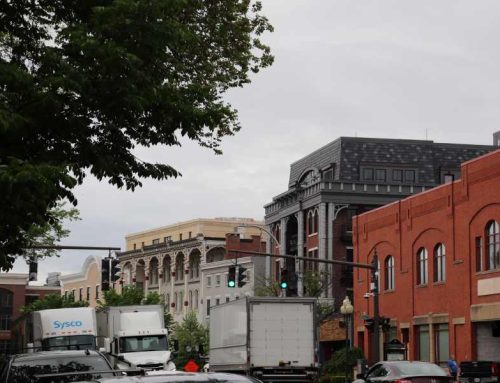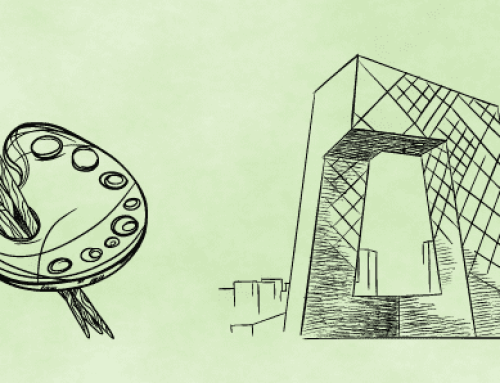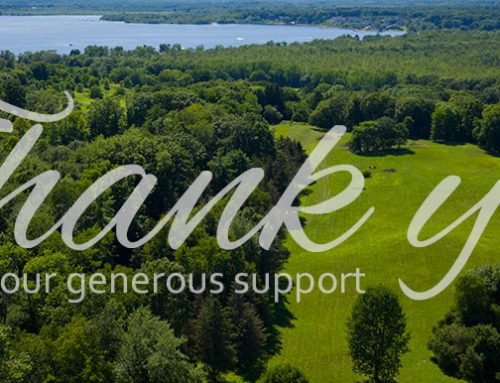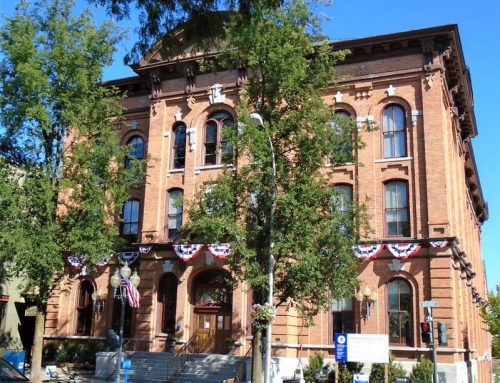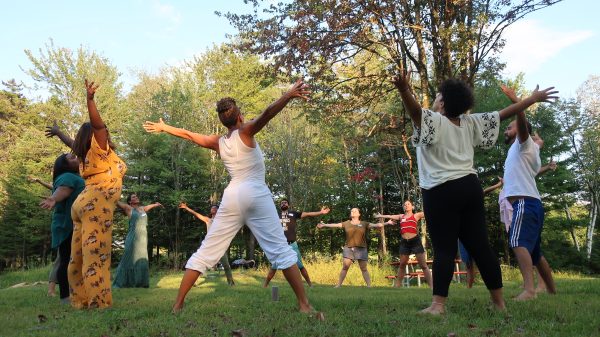
Photo courtesy of Soul Fire Farm
by Sarah Goodwin
Environmental justice
There are heroes in the world of environmental justice, and in the past two years we have focused on some of them. This month, we are spotlighting not one hero, but a local community that is grounded in Black history, and that is visionary and inspiring: Soul Fire Farm.
First, let’s be clear about what Black History Month is and isn’t to Sustainable Saratoga. It is an opportunity to turn a specific lens to our mission and register some possible new directions for our work. It is not a time to mention environmental justice and then drop the subject for the next eleven months. It is an opportunity to reach out to our community and ask for ideas and collaborations.
Environmental justice as a movement has raised awareness of how racism has created imbalances in the ways land, air, and water pollution affects different populations. It has opened up research into how important it is for all people to have access to green spaces. Environmental justice has promoted understanding of the relationships among colonialism, labor and resource exploitation, climate change, and systemic racism. And it has contributed to exposing the history of racialized land ownership and farming in the United States. Its leaders and activists are responding to that history with new visions.
Soul Fire Farm is one example among a growing number of collectives nationally that are working to transform Black farming into a model of social justice and sustainability. And Soul Fire is not far from Saratoga, near Hoosick Falls, part of our regional farming community.
Black-owned farming in the U.S.
At the end of the Civil War, the majority of Black Americans worked in agriculture—as much as 70 percent in the Southern states. But it was very difficult for former enslaved workers to obtain land. Most owned little more than the clothes on their backs. Andrew Jackson tabled an act of Congress in 1865 that would have redistributed land among formerly enslaved workers. In 1867, Congress voted down another bill that would have redistributed land among formerly enslaved workers. Sharecropping became Black farmers’ primary employment, replacing slave labor while resembling it in many ways.
In the 1880s, during the Jim Crow era, Black banks and lending institutions emerged that enabled more farmers to buy land. Black teachers’ colleges and agricultural schools strengthened the knowledge and power base for Black farmers. In the first decade of the twentieth century, cotton prices rose dramatically, and more Black farmers established themselves in the South. By 1910, there were more than 240,000 Black farmers who owned their land, and 670,00 Black tenant farmers—approaching one million total.
But in 1914, the cotton market crashed, and white farmers and lending institutions closed ranks against the Black farmers. The period of steep decline in Black farm ownership began, and it continued throughout the twentieth century. By 1982, almost 94 percent of Black farms had been lost compared to the number of such farms in 1920. The loss of Black farms was one of the factors that drove the Great Migration northward. Another was the campaign of violence and intimidation that white supremacists waged against Blacks in the South. Banks foreclosed on properties. White posses burned or purged entire towns and lynched Black individuals. Lynchings were especially prevalent in Southern counties where cotton was the main crop. Not surprisingly, Black land ownership declined steeply by the 1930s.
Despite an important report issued by the Commission on Civil Rights in 1982 with specific recommendations—The Decline of Black Farming in America—the decline has not been reversed. By 2012, there were just 44,629 Black farmers in the U.S., almost all in the South. The number of white-owned farms has also declined, but at a significantly slower rate. In 2017, Black farmers owned just 0.5 percent of all farmland in the U.S.
It remains to be seen whether the funds earmarked in the American Rescue Plan will have an impact on Black farmers who struggle to hold onto their lands despite the many aspects of systemic racism—along with the disadvantages faced by smaller farms—that continue to make it almost impossible.
Soul Fire Farm
Soul Fire Farm—owned and operated by a Black and indigenous collective—offers a creative paradigm for farming. Its mission, according to its deep, thought-provoking, and resource-rich website (https://www.soulfirefarm.org/), is to be
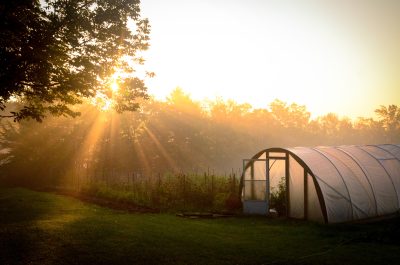
Photo courtesy of Soul Fire Farm
an Afro-Indigenous centered community farm committed to uprooting racism and seeding sovereignty in the food system. We raise and distribute life-giving food as a means to end food apartheid. With deep reverence for the land and wisdom of our ancestors, we work to reclaim our collective right to belong to the earth and to have agency in the food system. We bring diverse communities together on this healing land to share skills on sustainable agriculture, natural building, spiritual activism, health, and environmental justice. We are training the next generation of activist-farmers and strengthening the movements for food sovereignty and community self-determination.
Our food sovereignty programs reach over 50,000 people each year, including farmer training for Black and Brown growers, reparations and land return initiatives for northeast farmers, food justice workshops for urban youth, home gardens for city-dwellers living under food apartheid, doorstep harvest delivery for food insecure households, and systems and policy education for public decision-makers.
In other words, Soul Fire is much more than a farm, it is a community dedicated to teaching and seeding values that will enable more Black farmers to succeed. The values are visionary and transformative. They include maintaining best sustainable practices for farmers as well as educating non-farmers of all races and identities about the racism and other pressures that have had such disastrous consequences for Black farmers.
Soul Fire Farm’s website is a treasure-trove of information about what they have accomplished in the thirteen years since it opened as a functioning farm. They are focusing on “uprooting” racism in the food system with three areas that they seek to transform: Justice, Ecology, and Healing. The three initiatives are interconnected, and they reinforce each other. Among their goals for 2023 is to regenerate eighty acres of land using ancestral and other sustainable farming practices. Another is to continue building the national coalitions that will enable their work further to broaden its impact.
One very important project that Soul Fire has embarked on is participating in the reparations project that is ongoing within the Northeast Farmers of Color Network (https://nefoclandtrust.org/nefoc-network ) and the National Black Food and Justice Alliance (https://www.blackfoodjustice.org/ ). The project maintains a map of farms to which people and organizations can contribute reparations; Soul Fire is among the designated farms. As Soul Fire’s website says: “The food system was built on the stolen land and stolen labor of Black, Indigenous, Latinx, Asian and people of color. Members of the Northeast Farmers of Color Network are claiming our sovereignty and calling for reparations of land and resources so that we can grow nourishing food and distribute it in our communities.”
The history of Black farming in the U.S. drives us towards both sustainability and reparations.
 Further reading:
Further reading:
Browning, Pamela, and others. The Decline of Black Farming in America. Washington, DC: Commission on Civil Rights, 1982. https://files.eric.ed.gov/fulltext/ED222604.pdf
Douglas, Leah. “US Black Farmers Lost $326 Bn Worth of Land in the 20th Century – Study.” Reuters, May 2, 2022.
Meredith, Douglas. “A Brief History of America’s Black Farmers from the Past to the Present.” Hunger + Health: Feeding America. January 31, 2022. https://hungerandhealth.feedingamerica.org/2022/01/a-brief-history-of-americas-black-farmers-from-the-past-to-present/
Penniman, Leah. Farming While Black: Soul Fire Farm’s Practical Guide to Liberation on the Land. Chelsea Green Publishing, 2018. https://www.farmingwhileblack.org/

